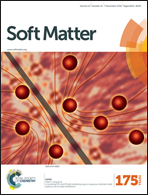Directed self-assembly of nematic liquid crystals on chemically patterned surfaces: morphological states and transitions†
Abstract
The morphology and through-film optical properties of nematic liquid crystals (LCs) confined between two surfaces may be engineered to create switches that respond to external electric fields, thereby enabling applications in optoelectronics that require fast responses and low power. Interfacial properties between the confining surfaces and the LC play a central role in device design and performance. Here we investigate the morphology of LCs confined in hybrid cells with a top surface that exhibits uniform homeotropic anchoring and a bottom surface that is chemically patterned with sub-micron and micron- wide planar anchoring stripes in a background of homeotropic anchoring. In a departure from past work, we first investigate isolated stripes, as opposed to dense periodic arrays of stripes, thereby allowing for an in-depth interpretation of the effects of patterning on LC morphology. We observe three LC morphologies and sharp transitions between them as a function of stripe width in the submicron and micron regimes. Numerical simulations and theory help explain the roles of anchoring energy, elastic deformation, entropy, pattern geometry, and coherence length of the LC in the experimentally observed behavior. The knowledge and models developed from an analysis of results generated on isolated features are then used to design dense patterned substrates for high-contrast and efficient orientational switching of LCs in response to applied fields.



 Please wait while we load your content...
Please wait while we load your content...